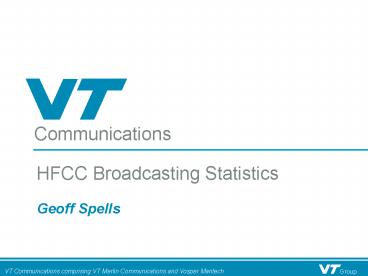Geoff Spells - PowerPoint PPT Presentation
Title:
Geoff Spells
Description:
VT Communications comprising VT Merlin Communications and Vosper Mantech. Group. Geoff Spells ... To produce valid statistical information, database should contain: ... – PowerPoint PPT presentation
Number of Views:27
Avg rating:3.0/5.0
Title: Geoff Spells
1
HFCC Broadcasting Statistics
- Geoff Spells
2
Overview
- HFCC/ASBU/ABU-HFC joint HF seasonal schedule
database - Technical Analysis
- Statistics derived from database and technical
analysis - Conclusions
3
Database Used for Analysis
- To produce valid statistical information,
database should contain- - All HF broadcasting requirements world wide
- Requirements to be those actually used in
practice - Realistic technical assessment of congestion
- Although a number of HF broadcasting databases
exist, Operational joint HFCC/ASBU/ABU-HFC
seasonal database gives closest match
4
Operational HFCC/ASBU/ABU-HFC Seasonal Database
- Joint database is for each of 2 seasons per
year- - A - end March to end October
- B - end October to end March
- Contains majority of broadcasting requirements
- Contains requirements for frequencies outside HF
bands allocated to broadcasting service - Data at around 1 month after start of
broadcasting season used for analysis - Limited monitoring results indicate data is at
least 95 accurate
5
All co-ordination groups
6
(No Transcript)
7
Technical Analysis
- Technical analysis performed using
Recommendations ITU-R P.533 and BS.705 - Fieldstrength at each of the ITU 912 test points
calculated for each hour for specific months each
season - CIRAF ZONE quadrants identified where requirement
has fieldstrength greater than 55dB at one test
point within quadrant
8
Technical Analysis Collision Identification
- Interference situation (Collision) is identified
where for 2 requirements on the same or 5kHz
adjacent frequency - - Part of wanted service area of both requirements
is common - Unwanted requirement has fieldstrength greater
than 55dB in part of service area of wanted
requirement
9
(No Transcript)
10
(No Transcript)
11
Comments on Transmitter Hours
- Number of transmitter hours notified has
stabilised at around 16,000 per season - Overall reduction of 15 in hours since a peak in
2002 but reasonably stable for last 4 seasons - In bands between 4-10 MHz
- Contain more than half of hours coordinated
- Small overall variation in hours but recognisable
seasonal variation - Around 10 hours in WARC-92 bands
- Around 16 hours outside broadcast bands (OOB)
12
(No Transcript)
13
Comments on Satisfied Hours
- Results have been averaged across all seasons
from B00 to B06 - Bands below 6 MHz do not appear to be congested
probably due to requirements not included in
database - In bands between 6-10 MHz
- Inband frequencies are heavily congested
- WARC-92 band frequencies are less congested
- OOB frequencies are less congested still
14
(No Transcript)
15
Comments on Satisfied Hours
- Less than 62 of frequency hours are satisfactory
in each of the 6, 7 and 9 MHz bands - 7 MHz band appears most congested
- Congestion does vary with season so 4 MHz and 7
MHz become more congested in B seasons
16
Conclusions
- The Joint HFCC/ASBU/ABU-HFC is good basis for HF
broadcasting statistics - Although there has been a small reduction in
requirement hours in the last 5 years, the number
of transmitter hours appears to have stabilised
at around 16,000 hours per day - This overall reduction is due to a number of
complex factors which are difficult to quantify
17
Conclusions
- However, one such factor is the success of the
informal coordination procedure which has allowed
Frequency Managers plan and manage transmissions
in a more rational and effective manner - The bands between 6-10 MHz are heavily congested
so that more than a third of requirements are
unsatisfactory - Despite reports that HF broadcasting is dying,
statistics demonstrate HF broadcasting is alive
and thriving
18
Thank you for your attention































